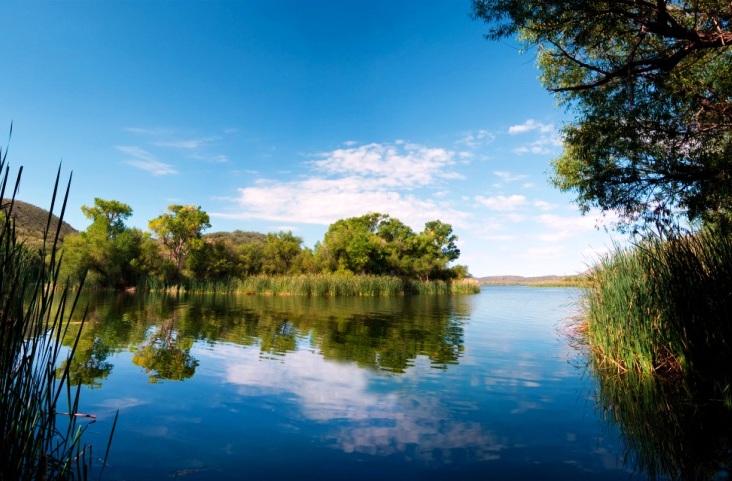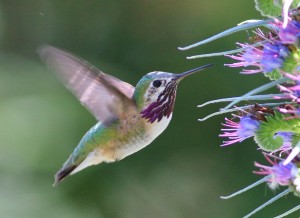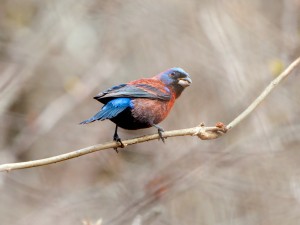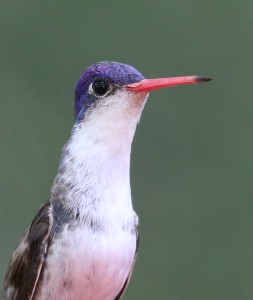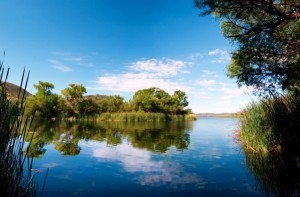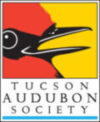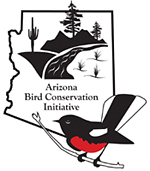Hummingbirds and Moon Rocks!
Trip report by Craig Anderson for his Arizona IBA Big Year.
To date by the numbers, I have visited 19 Arizona IBA’s, traveled 4,636 miles, spent $885 (excluding gas), and camped 31 days. I’ve had four individuals accompany me on one or more trips and I’ve seen over 225 species of birds.
Sonoita Creek State Natural Area/Patagonia Lake IBA:
Driving into Patagonia State Park was filled with the anticipation of visiting an old and cherished friend.
I have known this park for over twenty-five years and now I know it as an IBA. I first visited the park to see the Elegant Trogon that started showing up on a regular basis along Sonoita Creek many years ago. Over the years, there were numerous quests to find new vagrants from Mexico – such as the Nutting’s Flycatcher. That quest was fulfilled late one afternoon after almost a full days search, sometimes crawling on my hands and knees trying to catch a glimpse of the bird that frequently taunted me with its song and evasive behavior. This was my second visit. I was obsessed with finding the bird that had eluded me and so many other birders in the park. I was one of the lucky few to spot the bird deep within the mesquite bosque.
I also frequently visited the park wishing to introduce friends to the unique and always surprising birding along the lake, sometimes with a peaceful late afternoon glide on the lake in kayaks. I will always remember a February trip with a friend when we woke up to two inches of snow. How exhilarating it was to hike along the lake at day break and be the first witness the fresh footprints in the snow left behind by deer, javelina, coyote, bobcat and … a mountain lion with a cub. Ours were the only human tracks in the mix.
Then there is the unforgettable and often retold trip in which a great birding friend and I came face to face with a mountain lion crouched just 20-25 yards off the main trail during a dawn hike. We took many pictures, one of which later I turned into a watercolor painting. Turns out, the lion had just killed a cow and was in the process of laboriously dragging it back into the bosque. We later learned she was well-known by the Rangers and had three cubs that year.
It’s 4:47 A.M. on day one and I’m up and ready for coffee. We plan to be hiking the Sonoita Creek trail into that popular portion of the IBA by 6:00 A.M. So, we have time to wake up and have coffee and a protein shake.
One of the first things we notice as we start off are numerous improvements to the trail. There are new viewing areas above the lake and metal benches along the main trail. While the waterfowl have not yet arrived, they surely will before the crowds arrive during the upcoming Labor Day weekend. According to the Ranger, the campground is totally sold out and has been for several weeks.
It’s now official … there are several signs alerting hikers to the presence of mountain lions. The Ranger commented there are several living within the park. Deer, javelina and cattle keep them well fed. One wonders, if an occasional small dog might also help sustain them. The Ranger said, “I hate little dogs and cats but I love our lions!”
My favorite bird, the Vermilion Flycatcher, was one of the first to greet us as the sun began to rise over the surrounding hills. Always looking for feathers, Terri brought to my attention a squared off, white tipped feather of a wild turkey. Once again, as the result of a chat with the friendly Ranger, Dan, we learned that the turkeys are doing well and have naturally moved into the area.
We circled behind the lake and then followed the creek for about another one and one-half miles. It’s been over twenty years since I’ve seen the area so lush and green. The creek has been changed significantly by floods resulting from the raging monsoon rains this season. Rocks, sand, silt and the stream bed have been displaced leaving only the most obvious and solid land marks to guide our walk.
The three and one-half hour stealthy walk yielded fifty-two bird species, three of which were added to our overall total IBA species list. As usual, we were challenged by some of the birds in juvenile plumage this time of the year.
Our next exploration within this IBA was a visit to the portion of the IBA below the dam. This riparian area is restricted and requires permission to hike it from the Ranger’s Office. In order to protect the area, only 30 permits are issued each day. This little adventure turned out to be the surprise side trip of the week and well worth the effort. To bird this area, we parked at a designated area and then hiked about one-half mile down a steep winding road to the spill way. Because of the frequent rains, the lake water was up to the edge of the spill way. We hoped for waterfowl but only a few American Coots, a pair of Pied-billed Grebes, a lonely male Mallard and one Double-crested Cormorant were in the area.
Hiking down the spillway gulch was a geological adventure. The side walls appeared to be a mixture of red volcanic and iron laden rocks while below our feet was a gray ash-like sediment mixed with pebbles. Along the course of the small steam flowing from the spillway were periodic small pools. The pools were lined with tufts of grass, small bushes and sometimes small cottonwoods.
It was about one-half mile down this gulch and while approaching one of these ponds that Terri and I both gasped at the same time. A pair of Varied Buntings flushed from the grass at the side of a pool and briefly stopped at a small arrow bush. After the male showed off his dark deep purples, blues and reddish nape, it took off followed by the very dull beige female. Hoping for a return visit, we sought a shaded ledge overlooking the small water feature.
As often happens if one is patient, our vigilance for the return of one bird yielded some other special birds coming to the pool. During the next fifteen minutes we observed several Rufus-crowned Sparrows and a Thick-billed Kingbird. The distinctive Black-throated and Lark Sparrows also came to the pool along with two Cassin’s Kingbirds, an Ash-throated Flycatcher and numerous Mourning Doves. Hiking back to the car we enjoyed Lazuli Buntings, a Ladder-backed Woodpecker, a flyover of a Great Blue Heron headed for the lake, House Finches and several Nashville Warblers.
This little side trip will always be a part of future trips to Lake Patagonia!
Sonoita Creek TNC Preserve IBA and Paton’s:
The first birds to greet us at the Sonoita Creek TNC Preserve where the Violet-crowned, White-eared and Broad-billed Hummingbirds at the feeders hanging from the eaves of the Visitor’s Center. After paying our entry fee of $6.00/person, we check the “Recent Sightings” board. We note the sightings of the Gray Hawk, Lazuli and Painted Buntings – all birds of interest. While just being on the birding trails is usually enough incentive early on a beautiful morning, having a few “special’ birds to look for energizes the search. The preserve gets special recognition because it is a “pollinator corridor”. Volunteers have painstakingly planted hundreds of milkweed, thistle and other plants to sustain pollinators. We noted frequent boxes for wood-boring bees along the trails.
A male, a female and a juvenile Vermilion Flycatcher are the next birds we encounter. My spirits are always lifted by the sight of a male Vermilion with its colors exploding in my binoculars as the bird perches facing the morning sun. Terri and I follow the signs to the “Creek Trail”. This large loop trail follows Sonoita Creek giving the birder frequent views of the creek and its inhabitants. From scat and tracks it’s obvious that raccoons, deer, javelina, coyote and bobcat also make the preserve their home.
After only a short hike, we locate the Gray Hawks and a little further along the trail we come across a meadow of wild flowers and prairie grasses. The meadow hosted many Lazuli Buntings, Lesser Goldfinch, Green-tailed, Spotted and Abert’s Towhees, Common Yellow-throats and the bigger-than-life taunting calls of the Yellow-breasted Chats. We lingered here for thirty to forty-five minutes, discovering a new species every few minutes. This was our best hope for the painted bunting, but it was not to be today. One can’t be greedy however, having had the Varied Buntings the day before.
We finished the loop to the Railroad Trail. Also being a “railroad buff”, I’ve always enjoyed hiking along this old railroad bed of the Arizona and New Mexico Railroad. It operated from 1882 until 1962 hauling ore, cattle, freight and passengers from Patagonia to Nogales three times each day. The lush mixture of hemlock, scrub oak, cat claw, other bushes and flowering plants along with a small cienega make this a great habitat for thrushes, warblers and towhees. Frequently we got views of the large open meadows. We are hoping to get flycatchers and raptors during these brief stops.
After making the short drive from the preserve to Paton’s Hummingbird Garden we immediately appreciated the restoration and conservation efforts made by several Tucson Audubon members. A new water feature to the west of the old viewing area yielded the most unique birds. It was at this water feature, while watching Violet-crowned, Broad-billed, Rufus and the diminutive Calliope Hummingbirds feed that I met a very unique woman – Melissa from Switzerland. As we shared the joy of seeing these birds revisit the feeders, I learned that she flew from L.A. that morning to specifically photograph the Violet-crowned Hummingbird. Within two hours of landing in Tucson, her camera literally buzzed while she photographed the bird, often exhorting sounds of child-like glee.
I was intrigued by her obvious passion, curiosity and surprisingly deep knowledge of hummingbirds. She often referred to “the bible” of southwestern hummingbirds, which I informed her was authored by my friend Sheri Williamson. She asked about other places to see hummingbirds and we discussed Beatty’s in Miller Canyon. I love people with curiosity, passion and respect for the natural world. Melissa does not stop at photographing birds. She like me, spends time drawing/painting as a way of learning more about them. This multi-talented lady showed me some of her favorite drawings of Anna’s Hummingbirds that frequent a feeder outside her “work window”. They were good!
Inquiring further, I learned that the “work window” was at UCLA. Only to be further awed, I learned this bubbly woman crushed “Moon Rocks”. Yes, literally crushes priceless rocks brought back by astronauts on the lunar missions. She uses a lab at UCLA and is under contract with NASA. Her current research compares the crystal structures of Moon and Earth rocks to better understand the formation of the Moon and Earth from a cosmic collision between a probable asteroid and the Earth.
Another of her interests in the natural world are “super volcanoes”. So, we discussed the known information regarding the volcano at Yellowstone National Park … interrupted only by the activities of the hummingbirds in front of us. We exchanged contact information as birders often do and a promise to share future birding adventures if in each other’s area.
The final objective of this IBA adventure was a visit to the San Rafael grassland IBA. While it is too early to see visiting wintering sparrows and waterfowl, the grasslands never looked better to my eye. They appeared healthy and robust, probably the result of this year’s abundant monsoon rains. The sky was unusually clear and the vast stretch of the grasslands extending to row upon row of distant mountains was humbling – bringing tears of joy and appreciation to our eyes. We will come back to this magical area this winter.
The proper way to finish off a trip to Lake Patagonia is to kayak it at dusk and/or dawn. At these times the lake is usually quiet. Birds and campers are settled. On both ends of the day, you usually get to enjoy the magnificent colors of an Arizona sky and the special peace it brings to your heart.

